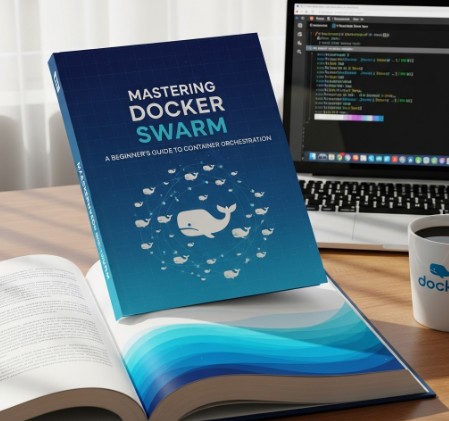Containerization has revolutionized software development and deployment, and Docker has emerged as the leading platform for managing containers. However, managing numerous containers across multiple hosts can quickly become complex. This is where Docker Swarm, a native clustering solution for Docker, comes in. This in-depth guide will serve as your comprehensive resource for understanding and utilizing Docker Swarm, specifically tailored for the Docker Swarm beginner. We’ll cover everything from basic concepts to advanced techniques, empowering you to efficiently orchestrate your containerized applications.
Table of Contents
- 1 Understanding Docker Swarm: A Swarm of Containers
- 2 Getting Started: Setting up Your First Docker Swarm Cluster
- 3 Deploying Your First Application with Docker Swarm: A Practical Example
- 4 Advanced Docker Swarm Concepts for the Ambitious Beginner
- 5 Docker Swarm vs. Kubernetes: Choosing the Right Tool
- 6 Frequently Asked Questions
- 7 Conclusion
Understanding Docker Swarm: A Swarm of Containers
Docker Swarm is a clustering and orchestration tool built directly into Docker Engine. Unlike other orchestration platforms like Kubernetes, it’s designed for simplicity and ease of use, making it an excellent choice for beginners. It allows you to turn a group of Docker hosts into a single, virtual Docker host, managing and scheduling containers across the cluster transparently. This significantly simplifies the process of scaling your applications and ensuring high availability.
Key Components of Docker Swarm
- Manager Nodes: These nodes manage the cluster, scheduling tasks, and maintaining the overall state of the Swarm.
- Worker Nodes: These nodes run the containers scheduled by the manager nodes.
- Swarm Mode: This is the clustering mode enabled on Docker Engine to create and manage a Docker Swarm cluster.
Getting Started: Setting up Your First Docker Swarm Cluster
Before diving into complex configurations, let’s build a basic Docker Swarm cluster. This section will guide you through the process, step by step. We’ll assume you have Docker Engine installed on at least two machines (one manager and one worker, at minimum). You can even run both on a single machine for testing purposes, although this isn’t recommended for production environments.
Step 1: Initialize a Swarm on the Manager Node
On your designated manager node, execute the following command:
docker swarm init --advertise-addr Replace
Step 2: Join Worker Nodes to the Swarm
On each worker node, execute the join command provided by the manager node in step 1. This command will typically look something like this:
docker swarm join --token : Replace
Step 3: Verify the Swarm Cluster
On the manager node, run docker node ls to verify that all nodes are correctly joined and functioning.
Deploying Your First Application with Docker Swarm: A Practical Example
Now that your Swarm is operational, let’s deploy a simple application. We’ll use a Nginx web server as an example. This will demonstrate the fundamental workflow of creating and deploying services in Docker Swarm for a Docker Swarm beginner.
Creating a Docker Compose File
First, create a file named docker-compose.yml with the following content:
version: "3.8"
services:
web:
image: nginx:latest
ports:
- "80:80"
deploy:
mode: replicated
replicas: 3
This file defines a service named “web” using the latest Nginx image. The deploy section specifies that three replicas of the service should be deployed across the Swarm. The ports section maps port 80 on the host machine to port 80 on the containers.
Deploying the Application
Navigate to the directory containing your docker-compose.yml file and execute the following command:
docker stack deploy -c docker-compose.yml my-web-appThis command deploys the stack named “my-web-app” based on the configuration in your docker-compose.yml file.
Scaling Your Application
To scale your application, simply run:
docker service scale my-web-app_web=5This will increase the number of replicas to 5, distributing the load across your worker nodes.
Advanced Docker Swarm Concepts for the Ambitious Beginner
While the basics are crucial, understanding some advanced concepts will allow you to leverage the full potential of Docker Swarm. Let’s explore some of these.
Networks in Docker Swarm
Docker Swarm provides built-in networking capabilities, allowing services to communicate seamlessly within the Swarm. You can create overlay networks that span multiple nodes, simplifying inter-service communication.
Secrets Management
Securely managing sensitive information like passwords and API keys is vital. Docker Swarm offers features for securely storing and injecting secrets into your containers, enhancing the security of your applications. You can use the docker secret command to manage these.
Rolling Updates
Updating your application without downtime is crucial for a production environment. Docker Swarm supports rolling updates, allowing you to gradually update your services with minimal disruption. This process is managed through service updates and can be configured to control the update speed.
Docker Swarm vs. Kubernetes: Choosing the Right Tool
While both Docker Swarm and Kubernetes are container orchestration tools, they cater to different needs. Docker Swarm offers simplicity and ease of use, making it ideal for smaller projects and teams. Kubernetes, on the other hand, is more complex but provides greater scalability and advanced features. The best choice depends on your project’s scale, complexity, and your team’s expertise.
- Docker Swarm: Easier to learn and use, simpler setup and management, suitable for smaller-scale deployments.
- Kubernetes: More complex to learn and manage, highly scalable, offers advanced features like self-healing and sophisticated resource management, ideal for large-scale, complex deployments.
Frequently Asked Questions
Q1: Can I run Docker Swarm on a single machine?
Yes, you can run a Docker Swarm cluster on a single machine for testing and development purposes. However, this does not represent a production-ready setup. For production, you should utilize multiple machines to take advantage of Swarm’s inherent scalability and fault tolerance.
Q2: What are the benefits of using Docker Swarm over managing containers manually?
Docker Swarm provides numerous advantages, including automated deployment, scaling, and rolling updates, improved resource utilization, and enhanced high availability. Manually managing a large number of containers across multiple hosts is significantly more complex and error-prone. For a Docker Swarm beginner, this automation is key to simplified operations.
Q3: How do I monitor my Docker Swarm cluster?
Docker Swarm provides basic monitoring capabilities through the docker node ls and docker service ls commands. For more comprehensive monitoring, you can integrate Docker Swarm with tools like Prometheus and Grafana, providing detailed metrics and visualizations of your cluster’s health and performance.
Q4: Is Docker Swarm suitable for production environments?
While Docker Swarm is capable of handling production workloads, its features are less extensive than Kubernetes. For complex, highly scalable production environments, Kubernetes might be a more suitable choice. However, for many smaller- to medium-sized production applications, Docker Swarm provides a robust and efficient solution.

Conclusion
This guide has provided a thorough introduction to Docker Swarm, equipping you with the knowledge to effectively manage and orchestrate your containerized applications. From setting up your first cluster to deploying and scaling applications, you now possess the foundation for utilizing this powerful tool. Remember, starting with a small, manageable cluster and gradually expanding your knowledge and skills is the key to mastering Docker Swarm. As a Docker Swarm beginner, don’t be afraid to experiment and explore the various features and configurations available. Understanding the core principles will allow you to build and maintain robust and scalable applications within your Docker Swarm environment. For more advanced topics and deeper dives into specific areas, consult the official Docker documentation.https://docs.docker.com/engine/swarm/ and other reliable sources like the Docker website. Thank you for reading the DevopsRoles page!

